PSYC21022 - Week 4: The developing brain
1/63
There's no tags or description
Looks like no tags are added yet.
Name | Mastery | Learn | Test | Matching | Spaced |
|---|
No study sessions yet.
64 Terms
Nature vs. nurture
Extent to which cognition and behavior (and brain development) can be attributed to genes or environment
Nature = genetic blueprint (things we are born with)
Nurture = experiences
History
Nature: Francis Galton (1874) - geniuses are born not made
Nurture: Freud; Skinner's behaviourism; Vygotsky
Middle ground (e.g., Piaget/neuroconstructivism): interaction between environment and genetic factors
Nature vs. nurture and the brain
Human brains are similar (functionally and structurally), but our experiences are different
Theories:
Blueprint analogy
Predetermined development
Probabilistic development
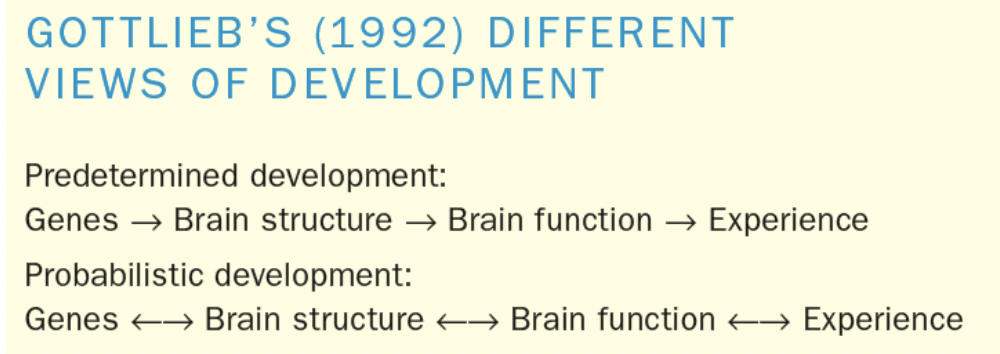
Blueprint analogy
genes will shape how the brain develops (predetermine each connection between neurons) -> hard to achieve, millions of connections
Predetermined development
genes will enable certain brain structure/functions, and this will enable experiences
Probabilistic development
modern dominant view - different levels interact with each other (experiences can affect genes, vice versa)
Prenatal brain development
Gestation around 38 weeks
When babies are born, they have similar brains to adult brains
Cell division
After 2 weeks -> Cell specialization
Proliferative zones: neurons and glial cells are produced
During early development 250,000 neurons are produced per minute
Neurons migrate to their final location
Neural tube differentiation
Many structural features of the brain emerge from other constraints
Folded cortex emerges from having lots of neurons
Pattern of gyri/sulci pulled into shape by tension of axon bundles (white matter tracts)
Hebbian learning: spontaneous electrical activity enables networks to form (e.g., electric activity from retina helps to form visual pathways)
Postnatal brain development
Majority of neurons formed prior to birth
Newborn born weighs 450g (vs. 1400g adult brain)
Postnatal increase in brain size:
Synaptogenesis
Myelination
Glial cell proliferation
Plasticity: experience dependent change in neural functioning
Experience alone can lead to small but observable structural changes (e.g., juggling, driving a taxi)
Increased grey matter: new synapses, dendrites, axon collaterals, glia cells
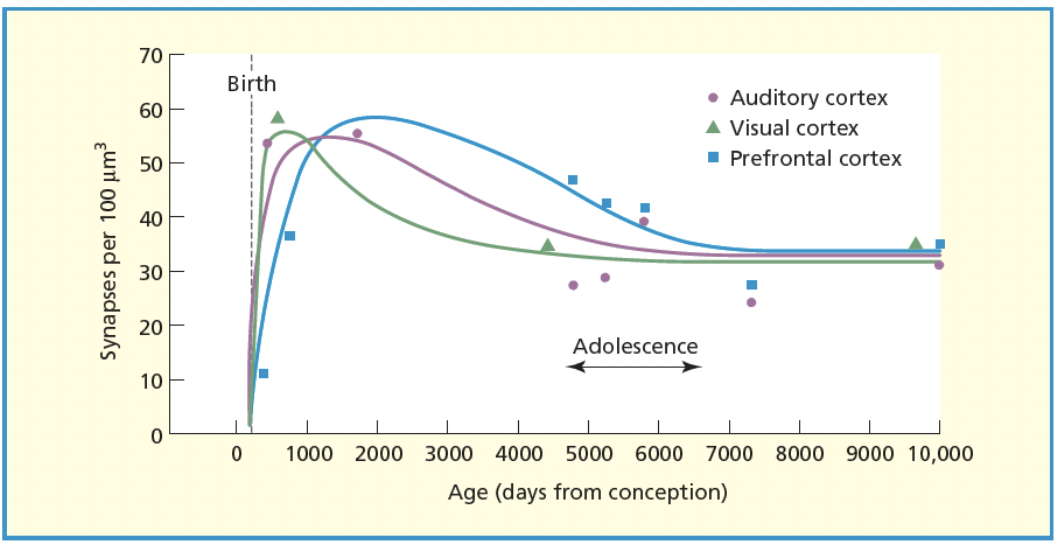
Synaptogenesis
Number of synapses will increase after birth
More synapses does not mean more efficient functioning
Fine tuning can help more efficient functioning (redundant connections eliminated)
Myelination
Fatty sheath around axons
Increases speed of info transfer
Glial cell proliferation
Increase in cells contribute to size increase
Plasticity
experience dependent change in neural functioning
juggling example
After practicing juggling, brain density increased
After stopping practicing, brain density decreases but not all the way
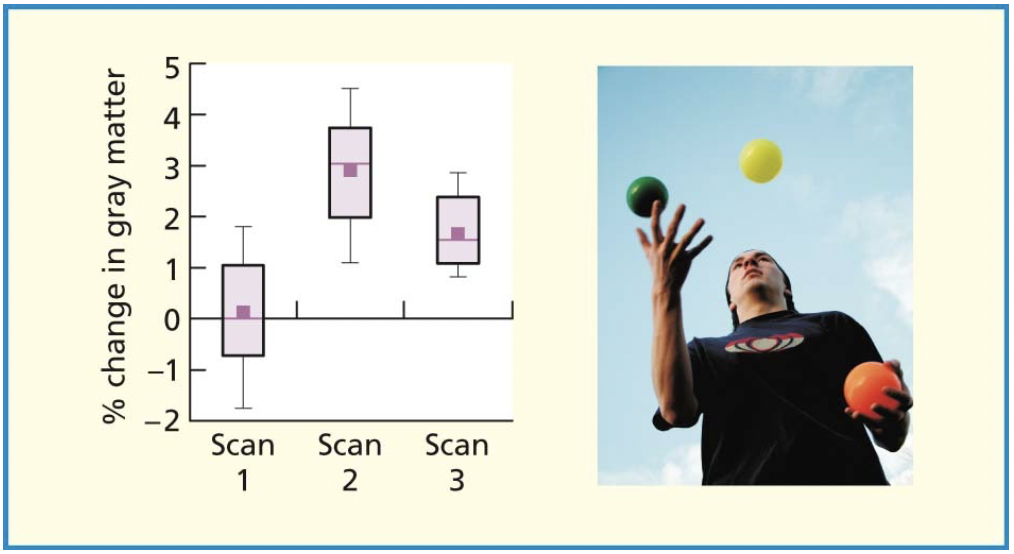
Functional brain development - Functional brain plasticity
prenatal brain damage can lead to major reorganization of tracts;
Functional brain plasticity has its limits
Spontaneous electrical activity enables networks to form intrauterine (prenatally) - these connections won't be fully lost
Opportunities for major reorganization are time-limited = critical or sensitive periods
Functional brain development - Case study: AH - no right hemisphere, only left hemisphere developed in the womb
Information from both visual fields was processed through the existing left hemisphere
Critical sensitive periods
2 main features:
Learning takes place within a limited window
But opportunity/timing can be extended in lack of experience
Not so strict/critical
This learning is hard to reverse by later experiences
But chicks imprinted to 1 object can generalize to similar objects (colour/shape)
Preference can be changed after sensitive period
Konrad Lorenz:
studied how birds recognize their mother
Filial imprinting
the processing by which young animals learn to recognize the parent
Happens between 15h-3 days
Movement is crucial
Critical sensitive periods - 2 possible explanations:
Genetically programmed synaptogenesis (readies brain for learning), followed by reduced plasticity (learned info is then 'fossilized')
Closure of window could be initiated by learning itself, i.e., environmental cues
E.g., particular gene plays a role in filial imprinting, it is switched off after exposure (need environment in order for time window to be closed)
Innate knowledge
Empiricist vs. nativist view
Empiricism: newborn mind is a blank state
Nativist: we are born with some knowledge
Modern view
Innate = readiness to learn (e.g., imprinting)
Knowledge or behavior that arises in the absence of appropriate experience
Development of cat visual cortex
Preferences in humans - sweet taste, visual pattern
Modern view - Development of cat visual cortex
Cat visual cortex
Doesn't matter if cat did or did not have visual experience (same after 14 and 21 days), visual cortex develops in the same way
But after 3 weeks, they need visual experience to form a major type of visual cortex (or else they won't be sensitive to visual info)
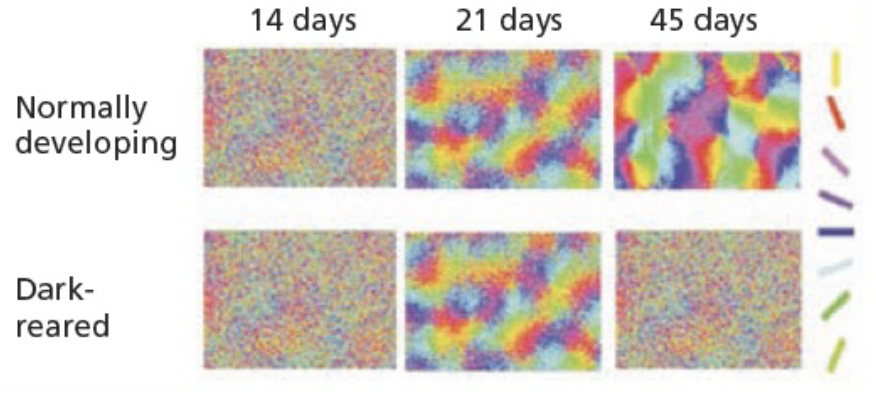
How can we investigate brain development? - Structure is 'easy' - prenatal ultrasound
Structural: different types of tissue (skull, grey matter, white matter, CSF fluid) have different physical properties
Used to create static maps
How can we investigate brain development? - Behavioural methods
We can infer brain development from behavior
E.g., preferential looking paradigm
How can we investigate brain development? - Functional neuroscience methods
Functional: temporary changes in brain physiology associated with cognitive processing (e.g., fMRI)
Problem
We ask participants to perform some kind of task (categorization, counting) or to sit still and look at images
Infants won't perform tasks and they won't stay still
How can we investigate brain development? - Functional neuroscience methods that can be used with infants and young children
Electrophysiological response (electromagnetic fields generated in the brain)
EEG/ERPs
Haemodynamic response (brain blood supply)
fMRI
fNIRS
How can we investigate brain development? - Infant EEG
Infant friendly EEG systems/solutions that allow quick installation
Infant friendly stimuli
More breaks during the study
How can we investigate brain development? - Infant ERPs
Some adult ERP peaks are present in infants but delayed
E.g., visual ERPs
N1/N290: perceptual and face specific component
Some ERP components are only present in infants and toddlers
Nc - negative central peak
Typically peaks between 300-700ms after stimulus onset
Reflect attention
Larger peak reflect higher attention
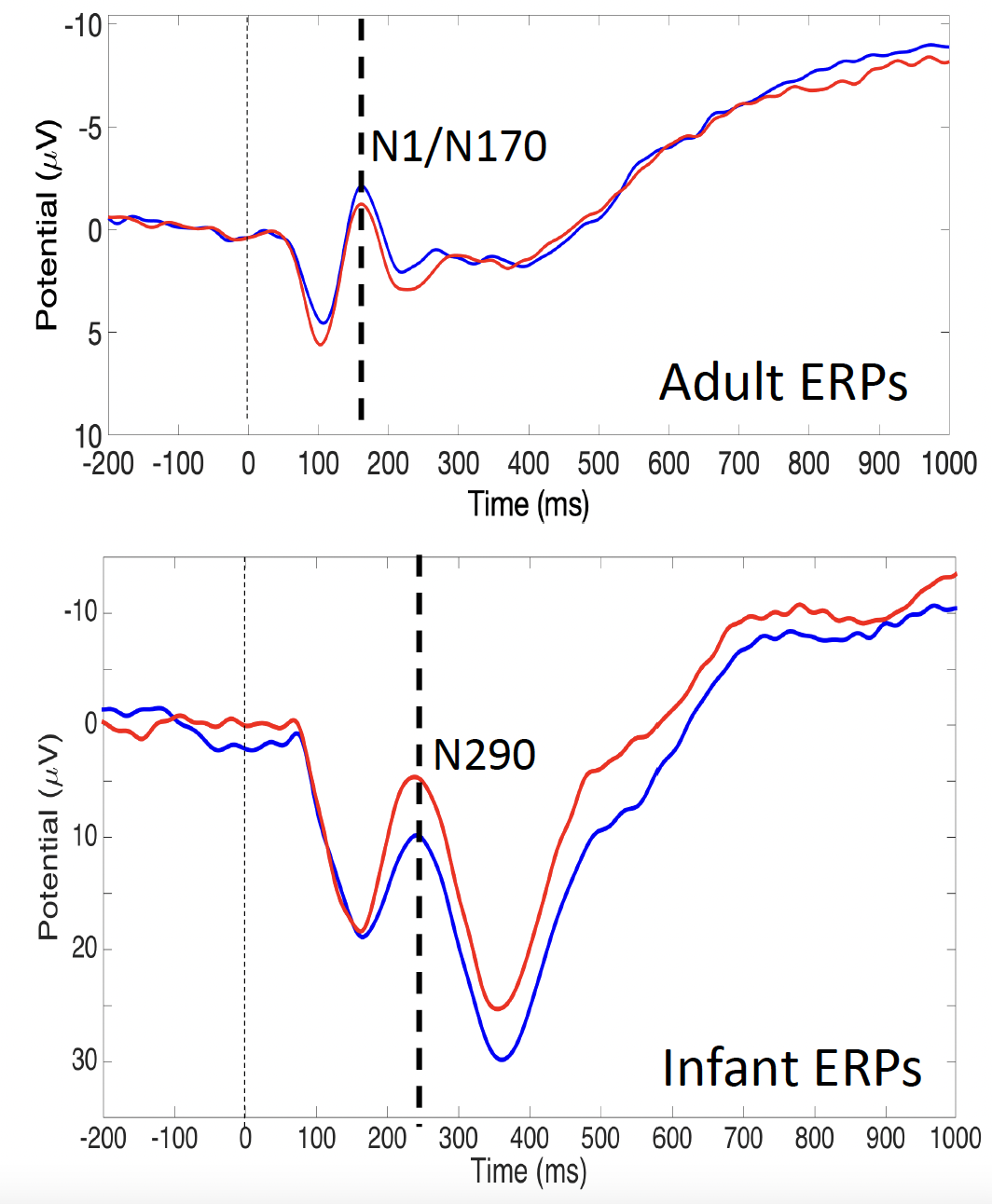
fMRI
Not ideal to use with infants
Highly sensitive to motion artifacts
Loud, restrictive environment
But there are recent attempts to use fMRI with infants
Custom headphones
Adjustable 32-channel coil
E.g., face specific activity in the brain (yellow)
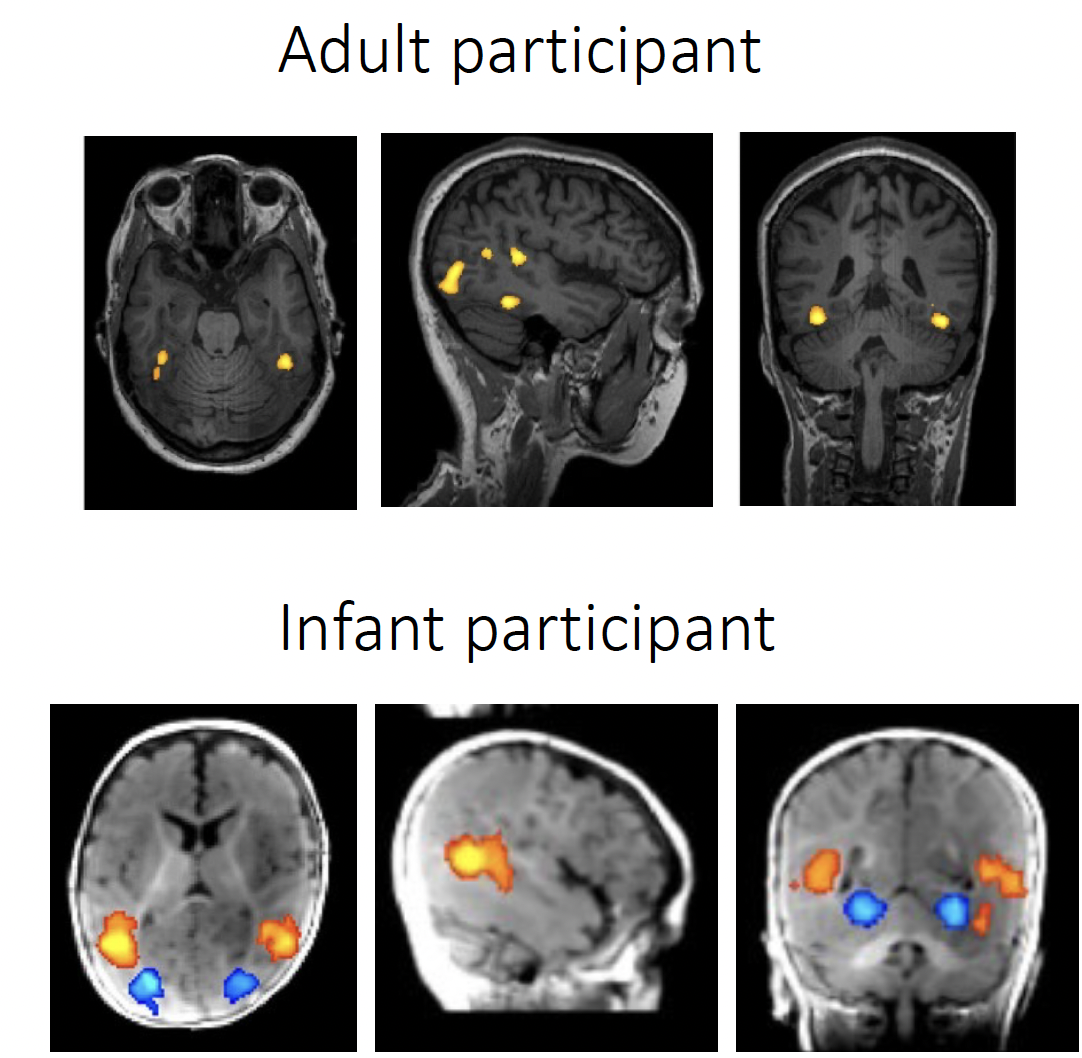
fNIRS
Similarly to fMRI: it measures BOLD signal
Unlike fMRI, it uses the near infrared spectrum of light
Skin, tissue, bone are mostly transparent to NIR light
Hb and deoxyHB absorb NIR
Emitter: emits NIR light
Detector: detect NIR light
Hb and deoxyHB absorb of NIR - from the difference between emitted and detected NIR, we can compute BOLD
Measures the concentration changes of oxyHb and deoxyHb focally, related to brain activity
Can be an appropriate substitute for fMRI for studying brain activity related to cognitive tasks
fNIRS pros and cons
Pros
fNIRS has lower spatial resolution
Only the surface of the cortex can be imaged
Often only a few sensors are used above a certain brain area
Cons
Portable
More tolerant of movement T
Historical perspective
some believed either genes or environment determined everything
Galton - importance of genes
Freud - experience
Piaget - interactionist perspective
Neuroconstructivism
emphasizes the interaction between genes and environment in shaping cognitive development
Structural brain development
investigate how the brain grows and changes, both before and after birth
Nature of developmental change
critical periods, sensitive periods, innate knowledge
Behavioural genetics
genetic influences on brain development and behaviour
Genetic code
Genetic code of brains makes human brains similar to each other, but it does not give a blueprint for individual brain structures
Think of the genetic code as a recipe for making a brain
Probabilistic and predetermined development
describes how genes and environment interact in shaping the brain
Predetermined development
Genes dictate brain structure, influencing brain function, determining our experiences
Genes have a deterministic influence on cognition
Probabilistic development
Genes and experiences influence brain structure and function
Brain structure and gene expression can be influenced by experiences
Effects of genes on brain structure are probabilistic
Even in the same environment, the same genetic program does not produce identical brain structures
i.e., implications for identical twins - similar but not identical brains due to the probabilistic nature of development
Prenatal development - Embryonic development of NS
Rapid cell division and differentiation forms neural tube
Neural tube: embryo's precursor to the CNS, consisting of a set of cells arranged in a hollow cylinder
5 weeks - tube develops into bulges that become diff parts of brain
Proliferative zones within tube produce neurons and glial cells (neuroblasts and glioblasts)
Neuroblasts: stem cells for neurons
Prenatal development - Neuronal migration
New neurons migrate outward to their final destinations in the brain
Process occurs…
Passively: older cells pushed to the surface of brain (i.e., hippocampus)
Actively: newer cell guidance from radial glial cells (i.e., neocortex)
Radial glial cells: support cells that guide neurons from the neural tube to their final destination
Factors influencing brain structure
Molecular signals influence structure, migration, survival of neurons
Different doses of these signals determine the dimensions of brain lobes
Formation of cortex
Develops in last few months before birth
Genetic mutations affecting neuron production can lead to convoluted cortical surfaces
Axon bundles place the cortical surface under tension, influencing its shape and variability
Axon guidance
Influenced by molecular signals (like neural migration), biasing how and where axons form
White matter tracts continue to develop a more fine pattern after birth
Spontaneous electrical activity in prenatal neurons
Prenatal neurons exhibit spontaneous electrical activity, helping form networks in the brain based on Hebbian learning principles
Hebbian learning: strengthening of a synapse that occurs when the presynaptic and postsynaptic neurons are active at the same time
Spontaneous electrical activity plays a crucial role in setting up synaptic pathways for later sensory processing
Postnatal development - brain volume expands
Most neurons are formed before birth, but brain volume expands after birth due to:
Synapse growth, dendrite and axon bundle growth, glial cell proliferation, myelination of nerve fibres
Postnatal development - Synaptic density changes
Rise and fall in synapse formation (synaptogenesis) in various cortical areas during development
Synaptic density peaks at different times in different brain regions
Fine-tuning the brain to match environmental needs renders some connections redundant, leading to a decrease in synapse numbers
Postnatal development - Myelination and white matter volume
Myelination, the increase in fatty sheath around axons, increases the speed of info transmission
Increase in white matter volume over the first 2 decades of life reflects the time course of myelination
Postnatal development - Plasticity and experience-dependent changes
Everyday experiences result in changes to the brain's structure
Learning new skills can lead to visible changes in brain structure, like increased grey matter density
Plasticity refers to experience-dependent changes in neural functioning, which can occur throughout life
Postnatal development - Gray matter density and cognitive ability
Gray matter density not always a simple proxy for cognitive ability
E.g., congenitally blind individuals may have more gray matter in their visual cortex; congenital amusia patients may have more gray matter in their auditory cortex
Gray matter changes can result from (a) developmental pruning of synapses (thinner is better) or (b) experience-dependent changes (thicker is better)
Postnatal development - Mechanisms underlying structural changes
cellular/molecular mechanisms that could underpin experience-related structural changes
Neurogenesis unlikely outside of the hippocampus
Other mechanisms like growing dendritic branches, synapses, axon collaterals could increase gray matter
Changes in glial cells, capillary vasculature, myelination can contribute to gray matter changes
Fractional anisotropy (in DTI) may increase as axons become more aligned or myelinated
Functional brain plasticity in rewired brains
In response to abnormalities, the brain can reorganize itself in unique ways (no genetic blueprint for each brain)
Case study of AH
AH, 10 YO girl, failed to develop a right hemisphere and right eye prenatally but had minor visual impairments
Visual info could reroute into the intact hemisphere, with neurons coding left AND right sides of space
Examples of brain rewiring in animals
Through surgical transplants or pathway severance
Prenatal visual cortex transplanted into somatosensory cortex responds to touch
Severed pathways from the cochlear to the medial geniculate nucleus reroute visual inputs into auditory cortex
Consequences of brain rewiring
Rerouted neurons can take on functional characteristics of the new region
Rewired areas may retain vestiges of their original connections and new representations may be less precise than normal regions
Limits of brain plasticity
Neurons are not fully interchangeable
Major reorganization appear to be time-limited, suggesting critical/sensitive periods
Critical and sensitive periods in development
Lorenz's study of filial imprinting in ducklings demonstrated a narrow window of opportunity for imprinting
Filial imprinting: process by which a young animal comes to recognize the parent
Movement of stimulus important for determining what object the duck will imprint to
Critical period: time window in which appropriate environmental input is essential for learning to take place
Sensitive period: time window in which appropriate environmental input is particularly important (not necessarily essential) for learning to take place
Critical periods have 2 features:
Limited time window for learning
Difficulty in reversing learning after the period ends
Possible in certain circumstances: chick imprinted to one object will often generalize to other objects of similar appearance
Examples of critical/sensitive periods
Hubel and Wiesel's study on cats showed a sensitive period for visual cortex development - deprivation leading to permanent changes
Language acquisition shows evidence of sensitive periods
Different components of language may have their own sensitive period (e.g., hearing, motor ability, working memory capacity)
Feral children and language acquisition
While Genie showed some language development after being rescued, her proficiency remained poor compared to young children
Second language acquisition
Differences in neural processing based on age of acquisition and proficiency level
Sensitive period
Properties of the NS and sensitive periods
Sensitive periods may be governed by a maturational timetable or self-terminating processes
E.g., genes may control timing of sensitive periods, and NS may wait for suitable environmental cues
Innate knowledge?
Empiricism: view that the newborn mind is a blank slate
Nativism: view that at least some forms of knowledge are innate
Instinct: behavior that is a product of natural selection
2 views of innate knowledge:
Innate as readiness for learning: some behaviours have a genetic basis but need suitable experiences to develop fully (e.g., filial imprinting, language acquisition)
Innate as independent of experience: certain behaviours/abilities emerge even without relevant experience (e.g., development of primary visual cortex in cats is innate but refined by experience)
Prepared learning:
common phobias are biologically determined from evolutionary pressures
E.g., fear of snakes
Requires suitable experience
Arguments for innate abilities
Newborns can imitate tongue protrusion without prior experience - innate ability for intermodal matching
Some dispositions, preferences, abilities may have innate components, but the specific content of knowledge is challenging to determine
Complexity of innate knowledge
Preferences for certain patterns (like faces) may have evolutionary roots, but specific knowledge can vary based on context and experience
While some behaviours may appear innate, they often interact with environmental factors, making it difficult to pinpoint purely innate knowledge
Functional near infrared spectroscopy (fNIRS)
Measures the BOLD signal
Does not have magnetic fields
Employs near-infrared light around 800 nanometres wavelength
Near-infrared light is sent to the brain, scattering more strongly by oxy- and deoxyhemoglobin
Degree of scattering used to calculate BOLD response, indicating neural activity
Advantages
Portability and tolerance to movement make fNIRS suitable for various applications
More affordable
Limitations
Can only capture neural activity close to the scalp due to its shallow imaging depth